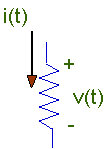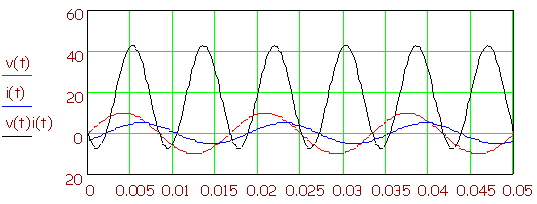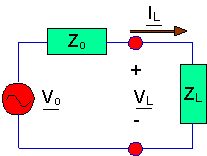Power In
AC Circuits
When an AC (sinusoidal) voltage is applied
to an impedance, both the current and the voltage are sinusoidal function of
time. That presents problems when calculating power because the power
fluctuates as the voltage and the current change.

Consider the case of a resistor. The current
and the voltage are given by:
v(t) = Vmax
cos(wt)
and
i(t) = Imax
cos(wt) = (Vmax/R)cos(wt)
and the power is given by:
P(t) = (Vmax
cos(wt))( Imax
cos(wt))
We can manipulate the power time function to see
things a little more clearly:
P(t) = (Vmax
Imax cos2(wt))
P(t) = (Vmax
Imax )(1 - cos(2wt))/2
This is an interesting result, because it really
says that the average power is:
Pavg = (Vmax
Imax )/2
You can convince yourself that this is true if you
consider that the average value of the cosine function over a period is zero.
What's left is the result above. In the early days of municipal electrical
distribution systems it was necessary to design light bulbs that worked on both
AC and DC. A 100 watt bulb that worked on a DC system had to work on an AC
system as well. There were many other reasons to worry about equivlance between
AC and DC systems, so there had to be some way of making things equivalent -
determining an equivalent AC voltage that produces the same power in a resistor
as that value of DC voltage. The convention since that time has often been to
represent AC signals in terms of a heating equivalent. For sinusoidal signals
that equivalent is given by:
Vequiv = Vmax
/(SQRT(2)
The effective value is then the peak value of the
sine voltage divided by the square root of 2.
Now, what happens if we have a general
impedance, Z, instead of a resistor R. Assume we have an impedance:
Z = |Z|/f
Then, we would have:
v(t) = Vmax
cos(wt)
and:
i(t) = (Vmax
/|Z|)cos(wt
- f)
So, now the power - as a function
of time - is given by:
P(t) = (Vmax
cos(wt))( (Vmax
/|Z|)cos(wt
- f))
P(t) = (V2max/|Z|)cos(wt)cos(wt
- f))
Example
Here is a circuit with the
following parameters.
v(t) = 10 sin(377t) Z = 2/45o i(t) = 5 sin(377t - 45o)
The current and voltage are plotted
in the plot below. In this plot the red trace is the voltage and the blue trace
is the current. The black trace is the instantaneous power - which we have to
talk more about.

First, note that the
voltage starts at zero, and has the look of a typical sine wave. The current
begins at a negative value in the plot, and peaks 45o after
the voltage. The peak value of the voltage is 10 v, and the peak value of the
current is 5 A.
Now, examine the power.
There are a number of interesting points in the plot of the instantaneous power.
There are times when the
instantaneous power is negative. At those times, the impedance is returning
energy to the source - energy which had to be stored previously in the
impedance. The peak power is around 42
watts - looking at the graph. Actually, we know the expression for the
power.
P(t) = (V2max/|Z|)cos(wt)cos(wt
- f)) P(t) = (V2max/|Z|)cos(wt)cos(wt
- f))
When a load is connected to
a Thevinin Equivalent Circuit (TEC), two things
happen - current flows from the source to the load, and the voltage across the
output terminals of the TEC usually drops. In the process, the load consumes
energy. There are many situations in which the rate of energy consumption - the
power delivered to the load - needs to be as large as possible. In this
section, we will examine the conditions under which that will occur.

Consider a TEC with an attached load as shown
in the figure at the right. The load draws power from the source. The source
is represented with a TEC that has an open circuit voltage phasor,
V0, and an output impedance,
Z0. When you have a
configuration like this, one question that arises is this:
How do you determine the load
impedance, ZL, which will draw the most power from the source?
In order to answer this question, you need to
account for the fact that the load impedance and the source impedance may both
be complex.
We will break both the output impedance,
and the load impedance into real and imaginary parts.
Z0 =
Z0,r + j Z0,i
ZL = ZL,r
+ j ZL,i
Now, the current flowing in the circuit is given
by:
IL =
V0/( Z0 + ZL)
and the power delivered to the load is given by:
|

